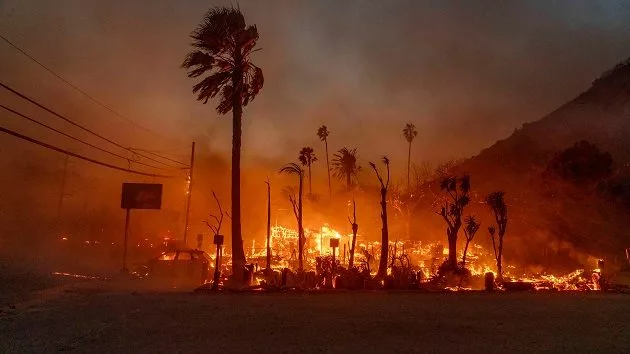
California to Require Home Insurers to Expand Coverage in Wildfire-Prone Areas After Major Carriers Stop Offering New Policies
SACRAMENTO, CA – In a historic move aimed at ensuring homeowners in wildfire-prone regions have access to vital insurance coverage, California Governor Gavin Newsom announced on December 30, 2024, that the state will mandate home insurers to expand coverage in areas affected by the increasing frequency and severity of wildfires. This decision comes after several of the state’s largest insurance providers halted new policy offerings due to the growing financial risks associated with the state’s escalating wildfire problem.
California has long struggled with the devastating effects of wildfires, which have been intensified by climate change. The decision to require insurance companies to cover homeowners in high-risk areas is seen as both a direct response to the financial burden these fires impose and a vital safeguard for residents who are increasingly vulnerable to losing their homes. As thousands of homes continue to be destroyed in wildfire events each year, the state’s insurance market has faced mounting challenges, leaving homeowners with fewer options for securing coverage.
The Growing Problem: Wildfires and Insurance Availability
Over the past few years, wildfires in California have become more frequent, larger in scale, and more unpredictable. As a result, a number of major home insurance companies have either significantly reduced their coverage areas or ceased offering new policies altogether in wildfire-prone regions. Companies like State Farm, Allstate, and Farmers Insurance have pulled back from offering policies in specific areas that have seen high levels of fire destruction. The Mountain Fire, which destroyed homes in Camarillo, California, this past November, is just one example of how devastating these fires can be to homeowners and their ability to retain insurance coverage.
According to the California Department of Insurance, an estimated 10% of California residents, roughly 1.3 million people, have been affected by changes in home insurance availability, either by losing their coverage or facing significantly higher premiums. In some of the hardest-hit regions, like Northern California’s Wine Country and Southern California’s foothills, homeowners are now unable to secure policies from traditional carriers. This has prompted the state to step in and take action to protect homeowners from the fallout of an increasingly volatile insurance market.
The State’s New Mandate: Ensuring Coverage in High-Risk Areas
In response to the growing crisis, Gayle Miller, the Commissioner of the California Department of Insurance, outlined the new state mandate that will require insurers to offer policies in areas deemed to be at high risk of wildfires. This regulation mandates that insurance companies must work with homeowners in these areas to provide policies that include coverage for the full value of their homes, including rebuilding costs, fire damage, and related destruction.
Under the new rules, insurance companies will be required to assess risk in a manner that goes beyond the current methods of calculating premiums based solely on the past history of fire incidents. Instead, insurers will be compelled to develop policies that take into account the growing risk of wildfire events exacerbated by climate change, with pricing structures that are more sustainable for homeowners in wildfire-prone areas.
“This is an unprecedented moment for California, and it’s a necessary step to protect our residents from the harsh realities of living in a state that faces increasingly dangerous wildfires,” Miller said during her announcement. “For too long, the rising costs and lack of options have left many Californians vulnerable. Now, with this mandate, we’re holding insurers accountable while ensuring that Californians will not be left behind when disaster strikes.”
In addition to the mandate for expanding coverage, the new regulation also requires insurance companies to offer discounts or credits to homeowners who implement wildfire mitigation measures. This could include clearing brush around their homes, installing fire-resistant roofing materials, or using fire-retardant substances on landscaping. These actions are intended to reduce the risk of fire damage and, in turn, allow homeowners to benefit from lower premiums.
Wildfire Statistics and the Need for Intervention
The urgency of the state’s new regulation is underscored by the growing scale of wildfires in California. According to the California Department of Forestry and Fire Protection (CAL FIRE), more than 7,000 structures were damaged or destroyed in the Eaton Fire alone, which recently ravaged parts of Altadena, a suburban area just outside Los Angeles. In addition, the Palos Verdes Fire in late 2024 threatened numerous homes in a wealthy part of Los Angeles, sparking renewed fears among homeowners about the future availability of insurance.
The Mountain Fire, which raged in the Camarillo area in November, further heightened concerns, destroying homes and prompting several major insurers to withdraw from writing policies in the region. According to fire officials, over 50 homes were lost in that blaze alone, with additional homes left severely damaged. The threat of wildfires now looms over many parts of California, creating an environment where home insurance has become an increasingly scarce resource, even as the risk continues to grow.
With fire seasons getting longer and more intense, many Californians are finding it impossible to secure insurance, forcing them to either self-insure or remain without coverage. The implications of this were made painfully clear in July 2024, when a California man whose home was damaged in the largest wildfire in state history was informed by his insurer that his coverage would be dropped just one month before the fire struck. His struggle highlighted the stark reality faced by countless homeowners as they fight to stay protected from the destruction that wildfires bring.
Financial Impact on Homeowners and Insurers
The financial burden for homeowners in wildfire-prone areas has become increasingly unsustainable. The rising premiums for home insurance, especially in high-risk areas, have pushed many residents to the brink. A report from the National Association of Insurance Commissioners (NAIC) indicated that in California, home insurance premiums have risen by as much as 40% in some fire-prone regions over the past five years.
For homeowners, the higher premiums and limited coverage options mean that in the event of a disaster, they may not receive enough compensation to rebuild their homes, let alone recover from the financial devastation caused by the fire. This has led to an increase in the number of residents seeking coverage through the California FAIR Plan, a state-backed insurer of last resort, though the coverage provided by the FAIR Plan is often limited and expensive.
For insurance companies, the financial impact of wildfires has also been significant. Insurers have been facing record payouts in the wake of large-scale wildfires, prompting many to reassess their exposure to risk. The California insurance market has become a high-stakes battleground, with some companies choosing to pull out of the market altogether rather than continue facing mounting losses. The new mandate for insurers to expand coverage, despite the risks, is seen as a necessary step to stabilize the market and ensure that homeowners continue to have access to the protection they need.
Looking Forward: Will This Regulation Solve the Problem?
While the new mandate is a step in the right direction, the question remains whether it will truly resolve the insurance crisis facing California homeowners. Experts have expressed concerns that the state’s intervention may not be enough to address the root causes of the insurance crisis, particularly the increasing frequency and severity of wildfires.
“We’re entering a new era of wildfire risk,” said Chris Johnson, a risk management expert at Risk Reduction Strategies. “While this regulation may provide some relief in the short term, it doesn’t address the long-term challenge of how we can sustainably live in a state that is growing more fire-prone every year. We need comprehensive climate action and investment in wildfire resilience to truly solve this issue.”
Some also worry that insurers may simply pass on the costs of expanded coverage to homeowners through even higher premiums, particularly for those in areas considered to be at the highest risk. The effectiveness of the state’s new rules will depend on the ability of insurance companies to balance risk and pricing without pushing residents out of the market entirely.
Conclusion: A Critical Decision for California’s Future
California’s decision to mandate insurance coverage for homeowners in wildfire-prone areas is a pivotal moment in the state’s efforts to safeguard residents from the destructive power of wildfires. With wildfires continuing to escalate and insurance options becoming scarcer, this move offers a glimmer of hope for homeowners who have felt abandoned by the insurance industry. However, the state’s regulatory action is not a cure-all, and only time will tell if it is enough to create a more sustainable and equitable insurance market for Californians facing the threat of wildfires. As the state continues to battle climate change, wildfire preparedness, and housing security, the coming years will determine how effective this new regulation truly is in protecting California’s most vulnerable residents.





